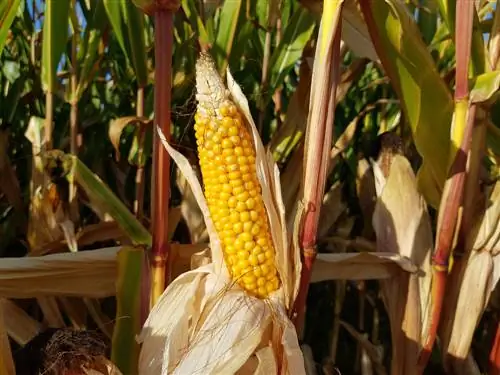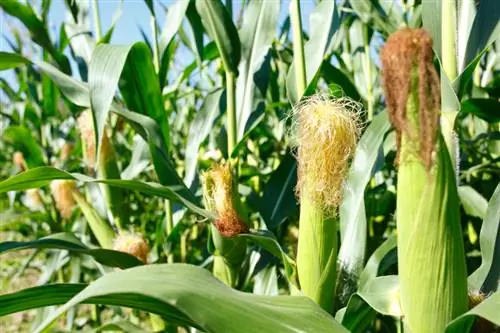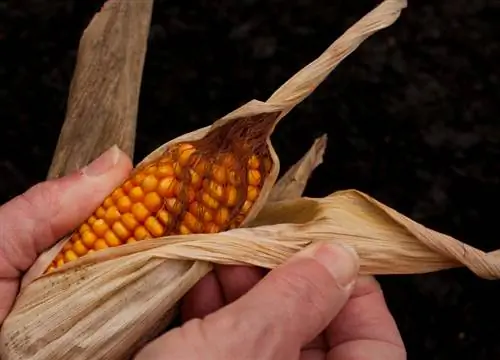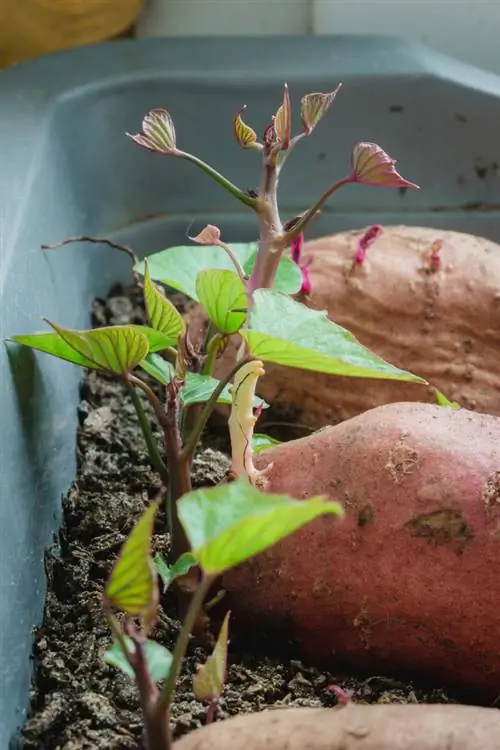- Author admin [email protected].
- Public 2023-12-16 16:46.
- Last modified 2025-06-01 06:02.
Read informative information about sweet corn in the profile here. Tried-and-tested tips explain how to grow sweet corn correctly, care for it easily, prepare it deliciously and make it last for a long time.
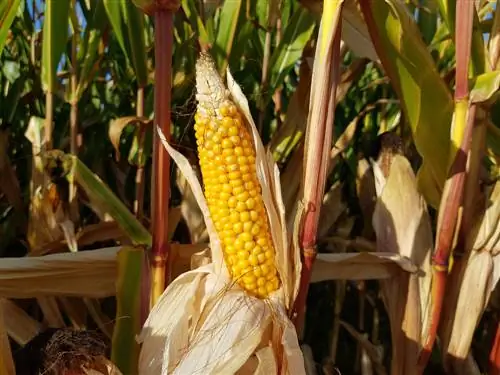
What is sweet corn and when is it ready to harvest?
Sweet corn, also known as sweet corn or vegetable corn, is an annual, herbaceous plant from the sweet grass family (Poaceae). It is grown for its sweet, golden-yellow corn kernels, which grow in cobs 10 to 40 cm long. The best time for harvesting is when milk is ripe.
Profile
- Scientific name: Zea mays
- Family: Sweet grasses (Poaceae)
- Synonyms: sweet corn, vegetable corn
- Occurrence: America, Europe, Africa, Asia
- Growth: annual, herbaceous, deciduous
- Growth height: 60 cm to 300 cm
- Flower: monoecious, separate sexes
- Flowering period: July to September
- Fruit: 10 cm to 40 cm long cobs
- Harvest time: end of July to October
- Drinking ripeness: Milk ripeness
- Shelf life: 1 to 3 days (refrigerated)
Where does corn grow?
Corn plants come from South America and have been cultivated in Europe since the 16th century. The heat-loving summer cereal began its triumph on the European continent in Spain and Italy. The first growing areas in Germany were in the mild winter Rhineland and Baden. A century later, corn had established itself as a nutritious and inexpensive crop. Today, corn grows around the world wherever a frost-free, warm, sunny cultivation period of at least 100 days can be guaranteed.
What does the flower look like?
Maize plants flower monoeciously with separate sexes. This means that each plant has male and female flowers. The flowers sit in different tiers on the monumental stem and differ significantly in appearance. The following properties characterize the flowers of sweet corn:
- Male flowers: inconspicuous, terminal, yellowish-purple panicles
- Female flowers: stalked cobs with green bracts, lateral in the leaf axil
- Pollination: wind transport
During the flowering period, long stigma threads, the so-called styles, grow from the female flower heads. These threads capture the male flower pollen.
When is sweet corn ripe?
Protected by the bracts, the corn kernels form on the flask-shaped fruit head during the ripening period. Sweet corn plants each produce one to three ears of corn, which reach a length of up to 40 centimeters by the start of the harvest season. You can recognize the perfect harvest time by the ripeness of the milk. At this stage the scar threads have dried brown-red. The corn kernels are golden yellow on the outside and soft on the inside. If you crush a grain, a white, milky liquid comes out. If in doubt, remove the husks from a sample corn cob and examine the corn kernels.
Did you know that types of corn differ not only in terms of growth, ripening time and taste, but also in the form in which the corn kernels pop in the popcorn machine? The knowledge magazine Galileo reveals the details:
Video: Five secrets about popcorn
Growing sweetcorn
In the German hobby garden, the cultivation of early to mid-early varieties of early to mid-early corn plants is recommended. For direct sowing outdoors, the Central European growing season is too short for a minimum cultivation period of 100 days. By growing sweet corn under glass, you give the young corn plants a real head start in growth. Don't miss these quick instructions:
Prefer sweetcorn
For sowing sweet corn, we recommend fresh, non-genetically treated seeds from a certified specialist dealer. Home-grown corn kernels are only suitable for cultivation to a limited extent because you can never be sure whether pollen from genetically modified corn plants from neighboring arable land had a hand in it. For optimal fruit production, only one type of maize is grown at a time. This is how you sow sweet corn correctly:
- Time window: mid-February to early March
- Fill cultivation pots with coconut soil or a mix of vegetable soil with sand
- Moisten the substrate with a fine spray
- Plant one corn kernel 4 to 5 cm deep in each pot
- Cover seed containers with a transparent hood or plastic bag
In a partially shaded window seat, keep the potting soil constantly slightly moist. Ventilate the cover for half an hour every day to prevent mold from forming. Read how long it takes for germination in the following table.
Germination temperatures table
| Temperature | Germination time |
|---|---|
| 10° Celsius | 22 days |
| 15° Celsius | 12 days |
| 20° Celsius | 7 days |
| 25° Celsius | 3 to 4 days |
When germination begins, you can remove the cover. Until the planting season begins outdoors, please water regularly and do not give any fertilizer.
Location
The following criteria characterize the perfect location for growing corn plants:
- Full sun, warm and preferably protected from the wind
- Nutritious, sandy-loamy soil
- Fresh, moist and well-drained
In rural areas, there should be a distance of 300 to 500 meters between your corn plants and fields with feed corn. Shorter distances pose the risk of undesirable cross-breeding to the detriment of crop quality.
Soil preparation
Secret of success in private corn cultivation is good soil preparation. Ideally, you should tackle the following work in the fall of the previous year:
- Removing crop residues, stones, roots, weeding
- Dig the bed two spades deep, sieve the garden soil, rake the soil several times
- Work 3 to 5 l of compost and 100 g of horn shavings into the surface per m²
- Wrinkle the bed area
Green manure with meadow clover, peas, vetches or lupins is advantageous. After mowing in spring, the legumes leave behind a nitrogen-rich soil with ideal conditions for the heavy feeder sweet corn.
Planting sweetcorn
The planting season begins at the beginning of May. In rough locations, please wait until after the Ice Saints. When growing sweet corn, planting in blocks or squares has proven to be excellent. How to plant sweet corn correctly:
- Pre-grown corn plants harden off for 14 days from mid/end of April in a partially shaded location during the day
- Place the potted root balls in water until no more air bubbles bubble
- Dig planting pits with 1.5 times the diameter of the root ball
- Unpotting and planting corn plants
- Planting distance in the row: 30 cm to 40 cm
- Distance between rows: 70 cm to 80 cm
- Press soil and water
A fleece cover protects the plants from late night frosts in the first few weeks. Mulching with compost or leaves keeps the roots additionally warm.
Excursus
Dream team sweet corn, beans and pumpkin
When you create a vegetable patch, a triumvirate of sweet corn, beans and pumpkin scores with unbeatable synergy effects. Corn plants serve as climbing aids for climbing beans. With their roots, beans enrich the soil with nitrogen for the heavy feeders sweet corn and pumpkin. Pumpkin plants serve as ground cover for corn and beans, suppress annoying weeds and protect the soil from drying out.
Harvesting sweet corn
Once the corn cobs have reached the stage of milk ripeness, the harvest season begins. For early varieties, the starting signal is given at the end of July. To harvest, you can simply hold the bulb with your hand and twist it off. Peel off the wrappers and enjoy the anticipation of the sugary-sweet treat for the palate.
Stems and leaves dry out in the following weeks and are suitable for the compost heap. If you don't want to wait that long, cut the harvested corn plants at ground level and shred the greens in the garden shredder for use as mulching material.
Care for sweetcorn
Watering, fertilizing and piling up are the three supporting pillars in the uncomplicated care program. This is how you care for sweet corn in an exemplary manner:
- Weeding several times a week
- Watering when the soil surface is dry
- Hill the stems at a height of 30 cm with compost soil
- Fertilize in mid-July with 100 g of horn shavings per m²
- Additionally fertilize every 2 weeks with diluted nettle manure (10 parts water, 1 part manure)
It is important to note that the need for watering increases gradually as the flowering period begins. If wet, cold late summer weather delays cob maturation, please remove the accumulated soil.
Diseases
The following diseases can be expected when growing sweet corn:
- Corn leg brandy (Ustilago maydis)
- Corn rust (Puccinia sorghi)
- Leaf spot (Helminthosporium sp.)
Corn blight is a fungal infection that only affects corn plants in Europe. Corn rust is caused by rust fungi and is a major headache, primarily in Central Europe. Another type of fungal infection is leaf spot, which mainly occurs in corn cultivation. To date, there are no known effective control measures approved for home gardens.
Preparing sweetcorn
Many delicious recipes for preparing corn make our mouths water. Sweet or s alty, grilled, roasted and fresh as a side salad - there is a delicious variation to suit every corn gourmet. Children and adults love to nibble the juicy, sweet corn kernels straight from the golden-yellow, perfectly cooked cob. The most important questions about the best preparation receive a compact answer here:
- How to cook? In water with a pinch of sugar and a pinch of good butter.
- How long to cook? Small ears of corn 10 minutes, large ears 15 minutes.
- When will it be ready? When corn kernels can be easily removed from the cob with a fork.
Preserving corn cobs - tips
As soon as it is harvested, the sugar contained in sweet corn turns into starch. After just 24 hours, the sugar content has been reduced by half. The result is a floury, bland taste. Good reasons to preserve freshly harvested corn cobs. This is how it works:
- One to three days: Wrap fresh corn cobs in a damp cloth and place in the refrigerator.
- Six to eight months: Blanch the corn cobs for 5 minutes, let cool, freeze in freezer bags.
- One year and longer: Push up the bracts, tie them in a bun, hang the corn cobs upside down to dry.
Popular varieties
Tasty corn varieties for private cultivation introduces you to the following selection:
- Golden Bantam: Premium variety, flowering period July to September, for freshly picked consumption, growth height up to 200 cm.
- Ashworth: very early variety, yellow corn cobs, good for cooler locations and small gardens, growth height up to 150 cm.
- Nana: great popcorn variety, cobs up to 20 cm long, compact growth up to 150 cm high.
- Damaun: Corn variety for impatient hobby gardeners with 85 to 95 days ripening time, delicious, extra sweet corn kernels.
- Medzid: medium early, resistant to diseases, stable, sweet corn cobs, 150 cm tall.
FAQ
What is the difference between sweet corn and feed corn?
In contrast to feed corn, the kernels of sweet corn taste mildly sweet. The types of corn grown as feed corn take on a floury taste at the end of the milk ripeness, which intensifies on the way to the dough ripeness. The milk-ripe, freshly harvested sweet corn kernels do what the name promises.
Is sweet corn he althy?
Sweet corn is a very he althy summer grain for the whole family. 100 grams of sweet corn contains a whopping 10 grams of fiber, 9 grams of protein, 16 grams of carbohydrates and 1 gram of fat. Furthermore, the corn kernels are full of he althy minerals such as potassium, magnesium, calcium, iron and many vitamins. With a slim 87 calories per 100 grams, vegetable corn is a delicious treat that doesn't end up on your hips.
How are freshly harvested corn cobs stored until they are prepared?
Corn cobs grown at home, from the weekly market or from the supermarket are best stored in the refrigerator. Wrapped in a damp kitchen towel to slow down the process of converting sugar into starch for one to three days. For a longer shelf life, you can blanch and freeze the cobs.

